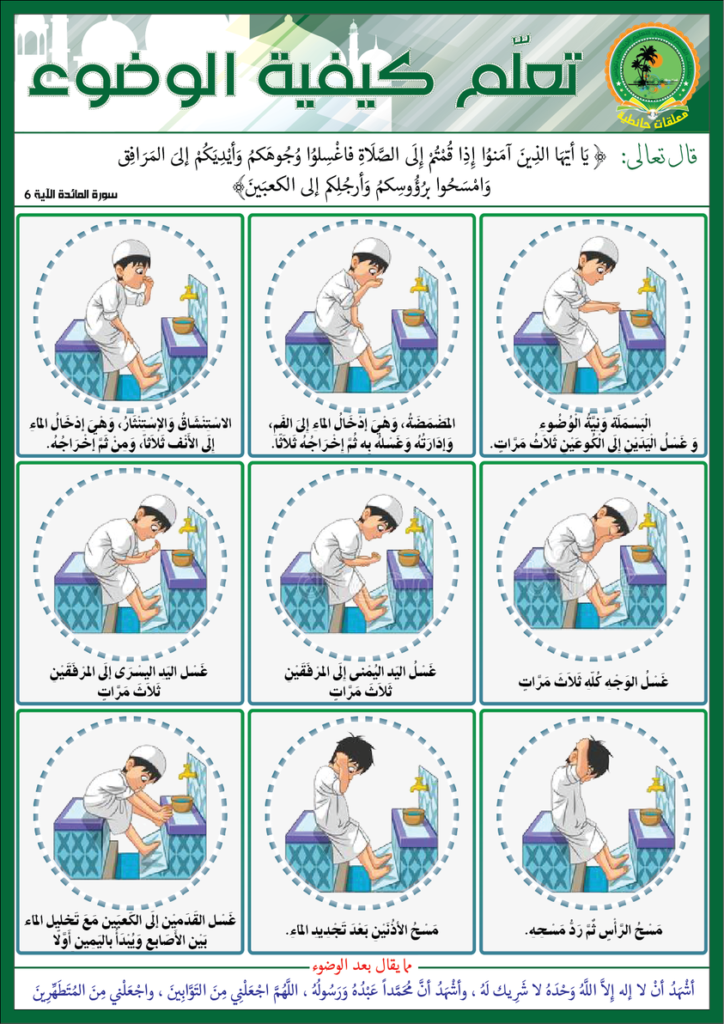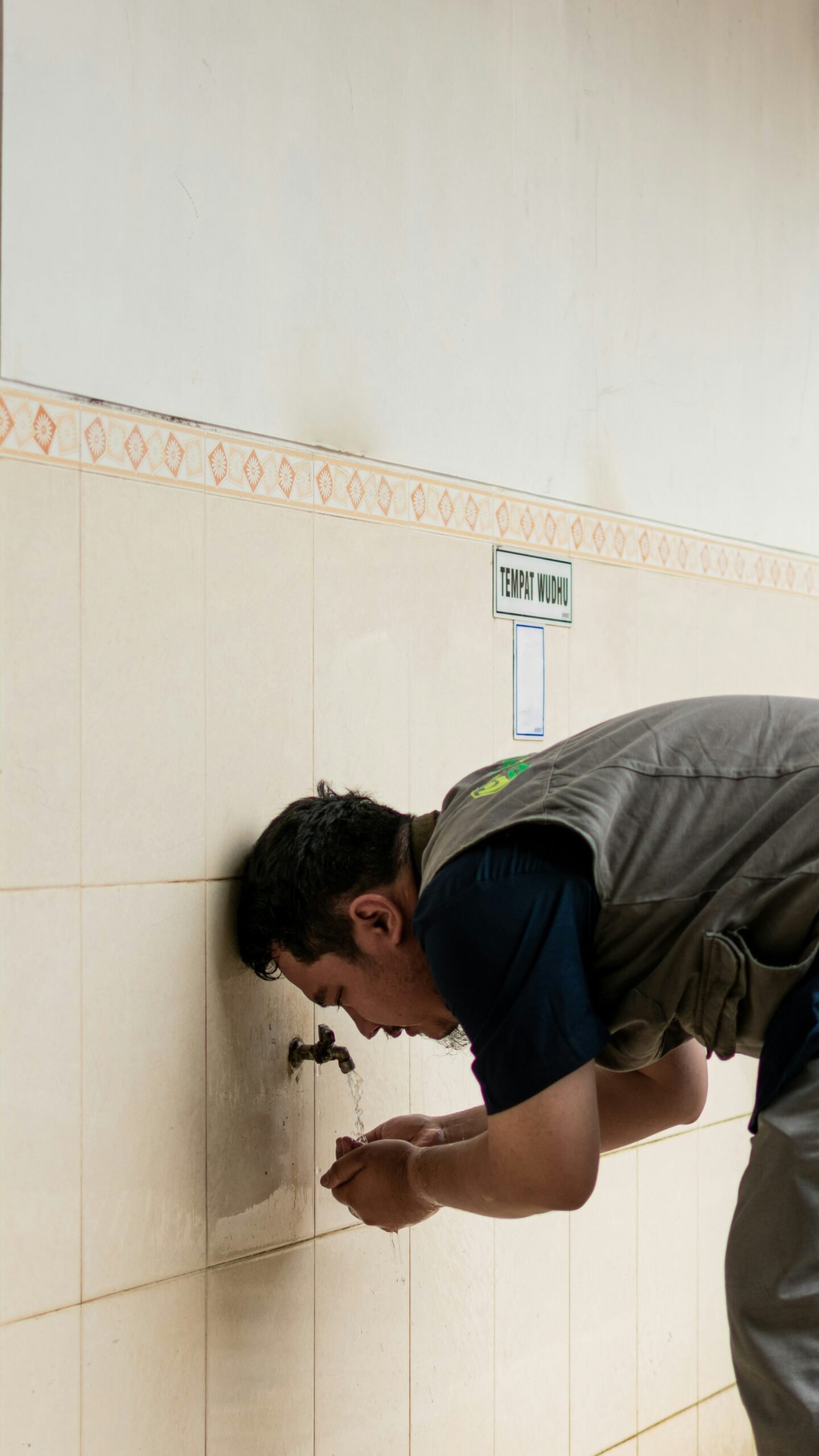In Islam, wudu (ablution) is a vital part of preparing for prayer. It is a process of purifying and cleansing the body before engaging in the act of worship. Wudu is considered a fundamental requirement for the validity of prayer and consists of several steps that ensure the physical and spiritual cleanliness of a Muslim before they stand before Allah.
1. Intention:
The process of wudu begins with a sincere intention in the heart to perform ablution solely for the purpose of prayer. This intention is an important aspect of the ritual, as it signifies the individual’s commitment and focus towards worship.
2. Washing the hands:
The first step of wudu involves washing the hands three times. It is important to ensure that every part of the hands, including the joints and spaces between the fingers, is thoroughly washed.
3. Rinsing the mouth and throat:
To cleanse the mouth and throat, water is taken into the mouth and rinsed three times. It is then expelled without swallowing it. This step helps to remove any impurities and freshens the breath.
4. Inhaling water into the nostrils:
Water is used to inhale into the nostrils three times, and then exhaled through the nose. This action not only cleanses the nasal passages but also symbolizes the purification of the inner self.
5. Washing the face:
The face is washed once, starting from the hairline to the lower part of the chin and from the right ear to the left ear. It is important to ensure that the entire face is covered, including the forehead, cheeks, and chin. This step signifies the importance of having a pure and sincere intention when approaching prayer.
6. Washing the arms:
Next, the arms are washed, starting from the fingertips up to the elbows. This is done three times, alternating between the right and left arm. By washing the arms, one symbolically prepares themselves to embrace and carry out the duties of prayer.
7. Wiping the head:
Using wet hands, the head is wiped, starting from the forehead, moving over the upper part of the head, and reaching the back. This action signifies humility and submission before Allah, acknowledging His authority and seeking His guidance.
8. Wiping the ears:
The outer part of the ears is wiped with the thumbs, while the inner part is wiped with the index fingers. This step emphasizes the importance of listening attentively to the words of Allah and following His guidance.
9. Washing the feet:
The final step of wudu involves washing the feet. Starting from the toes, water is passed over the heels and reaches the ankles. This is done three times, alternating between the right and left foot. Washing the feet symbolizes the grounding of one’s faith and the readiness to walk the path of righteousness.
Once these steps are completed, the wudu is considered complete, and the individual is now ready to perform the prayer. It is important to maintain the validity of wudu until the time of prayer. If wudu is invalidated, such as by urination, defecation, or deep sleep, it must be repeated before engaging in prayer.
Wudu serves as a physical and spiritual purification, preparing the individual to stand before Allah in prayer. It is a reminder of the importance of cleanliness, both externally and internally, and the need to approach prayer with a pure heart and mind.
In conclusion, wudu is an essential part of the Islamic prayer ritual. The steps of wudu, from the intention to the washing of various body parts, symbolize the purification of the body and the preparation of the soul for worship. By performing wudu before prayer, Muslims strive to attain a state of physical and spiritual cleanliness, enabling them to connect with Allah and seek His blessings.

الوضوء في اللغة مشتق من الوضاءة أي الحسن والبهاء، وفي الشرع الإسلامي هو:طهارة مائية تخص أعضاء معينة على صفة مخصوصة بنية التعبد، الأفعال المخصوصة هي: النية، وإيصال الماء إلى أعضاء مخصوصة. وأركانه: (النية وغسل الوجه، ثم غسل اليدين إلى المرفقين، ثم مسح الرأس ثم غسل الرجلين إلى الكعبين)، وهذه الأركان بمعنى: الأسس التي لا يصح الوضوء إلا بها، وهناك أفعال أخرى مشروعة للوضوء، منها ما هو فرض عند بعض العلماء كالترتيب، أو الترتيب والموالاة عند البعض، ومنها ما هو واجب عند البعض، كما أن للوضوء شروط وسنن وأحكام أخرى محلها كتب الفقه.
والوضوء عند علماء الفقه هو أول مقصد للطهارة؛ لأنه مطلب أساسي للصلاة، وهو من أهم شروط الصلاة وفي الصحيحين: «لا يقبل الله صلاة أحدكم إذا أحدث حتى يتوضأ».
تعريف الوُضُوء[]

الوُضُوءُ في اللغة:[1] مأخوذ من الوضاءة بمعنى: الحسن والنظافة والضياء. سمي الوضوء الشرعي بذلك؛ لأنه نور من ظلمة الذنوب ولما يضفي على الأعضاء من وضاءة بغسلها.[2]
وفي الشرع هو: «استعمال الماء في أعضاءٍ مخصوصة، مع النية»، أَو «أفعال مخصوصة هي النية، وإيصالُ الماءِ إِلى أعضاء مخصوصة، بدءاً بغسل الوجه، ثم غسل اليدين، ثم مسح الرأْس، ثم غسل الرجلين». وتكون النية عند غسل أول جزء من الوجه.
معنى الوضوء[]
الوضوء بضم الواو اسم للفعل وهو استعمال الماء في أعضاء مخصوصة وبفتحها اسم للماء الذي يتوضأ به وهو مأخوذ من الوضاءة الحسن والنظافة والضياء من ظلمة الذنوب وسمي بذلك لما يضفي على الأعضاء من وضاءة بغسلها وشرعا استعمال الماء الطهور في الأعضاء الأربعة وهي الوجه واليدين والرأس والرجلين.
فرائض الوضوء[]

فرائض الوضوء التي لا يتم الوضوء صحيحا إلا بها وهي:
- النية [3] لأن الوضوء عمل والنية واجبة فيه عند جمهور الفقهاء فلا يصح إلا بها وهل هي شرط من شروط صحة الوضوء أو ركن من أركانه؟ لا فرق، فهي واجبة على كل لقوله صلى الله عليه وسلم: «إنما الأعمال بالنيات» [4] ووقت النية في الوضوء:عند غسل اليدين ثلاث وينوي الإنسان.
- غسل الوجه من منابت شعر الرأس المعتاد إلى ما انحدر من اللحية طولا ومن الأذن إلى الأذن عرضا ومنه: المضمضة والاستنشاق عند القائلين بالوجوب كالمالكية، فلا يجوز ترك بعض الوجه مثل: مابين اللحية إلى الأذن، أو ترك الاستنشاق والاكتفاء بمجرد وضع الماء على الأنف وهذا كله داخل في حد الوجه المأمور بغسله في قوله تعالى: ﴿يَا أَيُّهَا الَّذِينَ آمَنُوا إِذَا قُمْتُمْ إِلَى الصَّلَاةِ فَاغْسِلُوا وُجُوهَكُمْ وَأَيْدِيَكُمْ إِلَى الْمَرَافِقِ وَامْسَحُوا بِرُءُوسِكُمْ وَأَرْجُلَكُمْ إِلَى الْكَعْبَيْنِ﴾. سورة المائدة آية: (6)
- غسل اليدين من أطراف الأصابع إلى نهاية المرفقين.
- مسح الرأس كله أو بعضه.
- غسل الرجلين إلى الكعبين.[5]
- الترتيب والموالاة.
سنن الوضوء[]

سنن الوضوء هي: التي يطلب فعلها إضافة إلى أركان الوضوء. وهي: المندوبات والمؤكدات لكن السنن المؤكدة يراد بها عند بعض العلماء «واجبات الوضوء» مثل التسمية، وغسل الكفين. ولها تفاصيل واسعة في كتب الفقه. وأهم سنن الوضوء.
- التسمية.[6][7]
- غسل الكفين قبل إدخالهما في الإناء.
- المضمضة وهي: إدارة الماء في الفم (غسل الفم). وهي واجبة عند الحنابلة.[8]
- الاستياك وهو: استعمال السواك عند غسل الفم. (وهو مستحب وليس واجباً)
- الاستنشاق، وهو: جذب الماء في الأنف. وهو واجب عند الحنابلة.[8]
- الاستنثار: وهو إخراج الماء من الأنف.
- مسح الأذنين ظاهرا وباطنا، ومسح الصماخين بماء آخر. «الصماخ: فتحة الأذن (المشتملة على الشمع)[9]»
- التثليث: في أفعال الوضوء بغسل اليدين ثلاث مرات والوجه ثلاثا والأقدام ثلاثاً بدءاً من الطرف الايمن ومنهياً بالايسر
- ، وباقي الأفعال في كل ثلاثا ثلاثا. ما عدى شعر الرأس والأذنين.
- مسح جميع الرأس بدءاً بمقدمه.
- الاقتصاد في الماء.
- هناك سنن أخرى، مذكورة في كتب الفقه.
